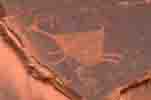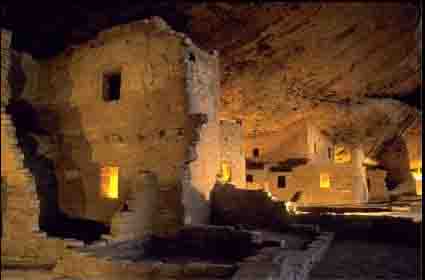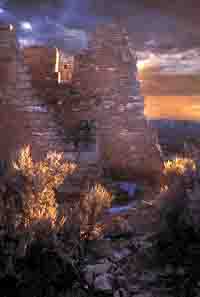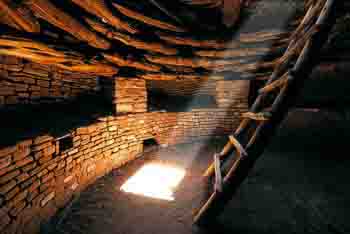 Trail of the Ancients
Trail of the Ancients
Follow the path of the indigenous peoples of the historic American West.
class=”wp-caption”>Story by Kathryn R. Burke. Photography by ©Jim Baumgardt, Image Counts
All content © San Juan Publishing Group, Inc, All rights reserved.
 [Four Corners] They lived here a millennium ago and left a mysterious legacy we are still trying to decipher. The Ancestral Puebloans, or Anasazi, inhabited much of the Four Corners area, living first in crude pit houses and later in sophisticated pueblo-style communities. These innovative people developed extensive trade routes, complex irrigation systems and a means of communication through petroglyphs and pictographs chiseled into and painted onto rock surfaces, a sort of “rock newspaper” for future generations to study. To follow their trail could take more than a lifetime, but the visitor with a little less time to spend might at least hit some of the highlights.
[Four Corners] They lived here a millennium ago and left a mysterious legacy we are still trying to decipher. The Ancestral Puebloans, or Anasazi, inhabited much of the Four Corners area, living first in crude pit houses and later in sophisticated pueblo-style communities. These innovative people developed extensive trade routes, complex irrigation systems and a means of communication through petroglyphs and pictographs chiseled into and painted onto rock surfaces, a sort of “rock newspaper” for future generations to study. To follow their trail could take more than a lifetime, but the visitor with a little less time to spend might at least hit some of the highlights.
 COLORADO
COLORADO
Mesa Verde, a World Heritage Site situated between Cortez and Durango, features cliff dwellings, cliff-top pit houses, museums, interpretive and interactive exhibits. Lodging, dining and gift shops are available. Anasazi Heritage Center in Dolores offers two ancestral sites and an excellent interpretive museum. Hovenweep National Monument’s unique multi-story towers perched on canyon rims and balanced on boulders are hauntingly beautiful at sunset and sunrise. Hovenweep straddles the border of Utah and Colorado.
UTAH
Monument Valley (Tsé Bli’ Ndzisgaii in Navajo, meaning valley of the rocks”) Tribal Park is right at the border of Utah and Arizona. A favorite location of western movies, the valley, starkly beautiful, is filled with towering red standstone buttes and monoliths, the most famous being “The Mittens.” Natural Bridges National Monument features three huge, stream-carved natural bridges as well as a concentration of Anasazi Indian ruins. The multi-colored bridges can be seen from overlooks along an nine-mile paved loop road through the monument.
ARIZONA
Navajo National Monument high on the Shonto Plateau, overlooking the Tsegi Canyon system in the Navajo Nation in northern Arizona, preserves three of the most intact cliff dwellings of the Ancestral Puebloans. Canyon de Chelly National Monument, Chinle Ariz., dates from A.D. 350 and 1300, although Navajos still live and farm here. Nearby, Window Rock, Ariz, is the capital of the Navajo Nation and the center of its tribal government with an excellent museum and annual fairs and celebrations well worth visiting.
NEW MEXICO
In New Mexico, near Nageezi, Chaco Culture National Historical Park contains thirteen major archaeological sites including kivas and multi-story dwellings. At Bloomfield, NM, stop at Salmon Ruins and its museum and 11th Century pueblo, then continue on to the Aztec Ruins (mistakenly named for Mexico’s Aztecs), just south of Durango. Both were actually built by a people thought to be closely related to the Chacoan culture, and were later occupied by a community with close ties to Mesa Verde
If you’re interested in the history of the American West and it’s indigenous peoples, this is a great way to learn about them. Plan a family learning trip of several days and take advantage of the excellent visitor centers provided by the National Park Service at most of these sites. To do them all justice, plan several days, even a week. Start in Colorado. Spend a day (or two) at Mesa Verde, then go west to Dolores and the Anasazi Heritage Center (two ruins and an interactive intrepretive center). Very early next morning exprience the silence and mystery of Hovenweep (east of Dolores), then loop back toward Durango for the night. From there, cross over into New Mexico to exerience Aztec and Salmon Ruins. Spend the night in Bloomfield (last stop before Chaco) and plan to spend the entire day at Chaco, another haunting site. From there, it’s west to Arizona and Window Rock (on the NM border), then Navajo National Monument, and finally Canyon de Chelley.
Trail of The Ancients National Scenic Byway, a federally designated National Scenic Byway circles the through the ancient Puebloan (Anasazi) Country of southeastern Utah, providing opportunity to view archaeological, cultural and historic sites, as well as Natural Bridges National Monument. An extension of this route continues into Colorado, to Mesa Verde and Canyons of the Ancients National Monument. (The byways program recommends five days to explore this area). Along the way you will also discover historic communities, and other signs of the ancients in less-known locations.
Photography
Top: “Message from the Anasazzi,” Hidden Valley, Ariz. Petroglyph in Monument Valley.
Above: “Hovenweep at Sunset”
Top right: Spruce Tree House, Mesa Verde. Lit up for the holidays.
Bottom right: Three Kiva Pueblo, ner Blanding Utah.
There are many more national and tribal parks in this historic region. We’ve presented a few here, but if you are planning a trip to study Native American culture in the American West, start here, then Google other options as they come along. Planning a trip is almost as much fun as actually taking it, so make the planning a family affair and try to include locations that are a priority for each family member!
Photographers Jim & Eileen Baumgardt, Image Counts, preserve precious historical resources with their exquisite images. Please visit our story about them, and visit their web site for more images.

